Seven Questions Over Breakfast with Greg Pizzoli
 October 22nd, 2013 by jules
October 22nd, 2013 by jules

 Pictured above is Matt Phelan’s rendition of author/illustrator Greg Pizzoli, who’s visiting me for breakfast today (and whose human version is pictured left). “I turned 30 in January,” Greg told me, “and my wife had some friends and family draw portraits of me for a book she made. It was called ’30 Portraits of Greg.'” So, Greg didn’t send all of those portraits for our chat this morning, but he did send some. Since they’re too fun to pass up, I’m including a few more below, scattered hither and thither.
Pictured above is Matt Phelan’s rendition of author/illustrator Greg Pizzoli, who’s visiting me for breakfast today (and whose human version is pictured left). “I turned 30 in January,” Greg told me, “and my wife had some friends and family draw portraits of me for a book she made. It was called ’30 Portraits of Greg.'” So, Greg didn’t send all of those portraits for our chat this morning, but he did send some. Since they’re too fun to pass up, I’m including a few more below, scattered hither and thither.
Greg saw his picture book debut this year (more below on how he took that road to publication). The Watermelon Seed was released by Disney-Hyperion in May, and it tells the story of one very worrisome crocodile dealing with what the Publishers Weekly review called a “[c]lassic kid fear.” (This is an “expert debut,” they also noted.) He’s swallowed a seed, and anxiety-ridden children the world over will find humor in the crocodile’s fraught facial expressions. (Vines could grow out of his ears after all.) Using bright colors, screenprints, and hand lettering, Pizzoli lays out a smartly-designed book (co-designed with Joann Hill), which was met with positive reviews all-around.
When I asked Greg about breakfast, he told me that coffee is always first. Ah. An illustrator after my own heart. “The tofu scramble with a side of potatoes and a biscuit from Sam’s Morning Glory is my favorite breakfast in Philly,” he added. “They make their own ketchup.” I’ll get the coffee brewing, and then maybe we can think about tofu scrambles for later.
I thank him for visiting today, sharing lots of artwork, and letting us know what is next for him.

Jules: Are you an illustrator or author/illustrator?
Greg: Author/Illustrator.
 Jules: Can you list your books-to-date?
Jules: Can you list your books-to-date?
Greg: Out now [May 2013]: The Watermelon Seed (author/illustrator), published by Disney Hyperion.
Coming in 2014: Number One Sam (author/illustrator), Disney Hyperion; Carol Brendler’s Not Very Scary (illustrator), Farrar, Strauss and Giroux.
Coming in 2015: Tricky Vic (author/illustrator) from Viking Children’s Books.
Jules: What is your usual medium?
Greg: I’m trying to mix things up recently. Typically, I draw in pencil or brush with ink on paper, scan things into Photoshop to reassemble and collage them. Often I re-draw them on the computer and color separate them for screenprinting or spot colors, using a Wacom tablet. My process is grounded in printmaking, and I try to keep that feeling even when working digitally. Depending on the publisher, I sometimes get to make my work using spot colors, which I really enjoy. Right now I’m working on a dummy for a picture book about a dragon, and I’m trying to do most of it with rubber stamps. I have no idea if it will work or not.


Jules: If you have illustrated for various age ranges (such as, both picture books and early reader books OR, say, picture books and chapter books), can you briefly discuss the differences, if any, in illustrating for one age group to another?
Greg: So far, I have only done picture books, but they’ve all been different, all challenging and rewarding.
Jules: Where are your stompin’ grounds?
Greg: Going on seven years in Philadelphia. It’s both wonderful and horrible.

Jules: Can you tell me about your road to publication?
Greg: If it’s cool with you, I’m just going to ignore that “briefly” comment.
I made hand-printed and sewn children’s books for my graduate school thesis in 2009. The better of the two was titled Where the Night Train Goes and featured an owl with a serious case of self-doubt. I screenprinted these 36-screen little monsters myself and bound an edition of 100. Here are some pics:



And then, I suspect like most MFA students, I graduated with $80,000 of debt and got a job answering phones at an office. I worked there for a little over two years. They were nice to me and let me off early one afternoon each week so I could teach. I started teaching undergraduate and Continuing Education screenprint classes immediately after graduating.
I met author/illustrator Brian Biggs when he signed up for my first Continuing Ed Screenprinting course. We were doing the ice-breaker thing you do on the first night of classes, and he said he was a children’s book illustrator. I sort of rolled my eyes and went to the next person, I think.
Then I looked him up after class and holy crap — he wasn’t kidding! He was the real deal. Here was a guy who did what I wanted to do, and I had access to him for at least ten weeks. I taught him to screenprint, and (over beers after class) he taught me about books and illustration and making a living doing what you want.
Here’s Brian’s first print from class (made using stencils cut from construction paper):

Unbeknownst to me, he took the liberty of sending my work to his literary agent, Steven Malk, and they both guided me through a couple years of building up my portfolio. Many evenings after work were spent hitting refresh on my email during that time. Many, many postcards and zines and screenprinted holiday cards sent to publishers and editors and art directors. Steve’s advice was to slow down and get good. It wasn’t what I wanted to hear at the time, but he was definitely right. Brian’s advice was to make as much as possible and get good. He was right, too. Steve eventually took me on as a client, and I continued to work on my portfolio while working that day job and teaching.
Here are some photos of promotional postcards and stuff like that I have made. The black and white image is a scan of some of the rubber stamps I’ve made for the outside of the envelopes:

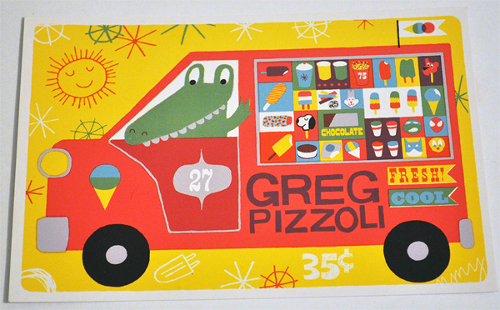






I attended my first SCBWI conference in January 2011 and was blown away when I won a portfolio honor award. My editor Rotem saw my work there, and we started talking about projects. Then I went to the LA SCBWI conference and, again, won an honor award for my portfolio. This was nuts. I went back to work the Tuesday after the conference and gave my notice. It was time to go. Many nights of checking my bank account and health insurance policy during this time.
About a month later, Rotem signed me up for my first book contract, which was for The Watermelon Seed and Number One Sam. Since then, things have been rolling along well, and I’m very lucky to have some pretty incredible projects on my plate.

Jules: Can you please point readers to your web site and/or blog?
Greg: www.gregpizzoli.com; www.gregpizzoli.blogspot.com; www.twitter.com/gregpizzoli.
Jules: If you do school visits, tell me what they’re like.
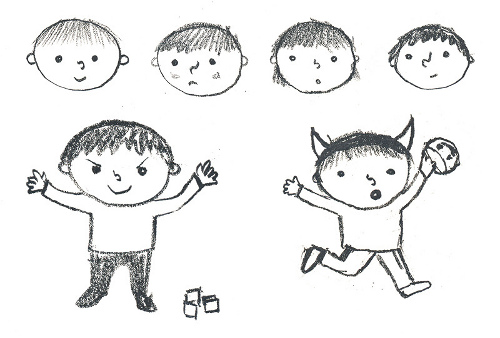
Greg: I’ve only done a few at this point, but I enjoy them. They do make me a little nervous, but I like testing new ideas out on the kids. I usually read a couple of books and do some drawing and answer some questions. My cat’s name and stuff like that. I think once the nonfiction stuff I’m working on starts to come out next year, I’ll have more of a range for school visits, and I hope to do many more.
I recently did one in Toronto with my friend Bob Shea, who is just annoyingly talented at things like that. He’s got fancy markers and a big smile. I didn’t tell him at the time, but when we were presenting together I wanted to run and hide behind his giant … talent.
Here’s Bob and I at this year’s Toronto Comics Art Festival in—that’s right—Toronto:

7-Imp: If you teach illustration, by chance, tell me how that influences your work as an illustrator.
Greg: This is a hard one. I’ve taught screenprinting at the college level for four years, but I’ve only taught two illustration courses so far, and one I was co-teaching with Zach Ohora and Matt Phelan. The good students excite me. The lazy and/or entitled students really, really annoy me. Right now, I’m happily busy with book projects and only teaching one class per semester. It’s a nice balance. I can envision a time in the future when I will want to teach more, but not just yet.

Jules: Any new titles/projects you might be working on now that you can tell me about?
Greg: Next year (2014), I have three titles coming out. The first is my next book with Disney-Hyperion, which I wrote and illustrated. It’s called Number One Sam. It’s about a race car-driving dog, who is always number one — until he isn’t. Here are some pictures:
Later in the summer, FSG is publishing Not Very Scary, a Halloween counting book, written by Carol Brendler. I drew the pictures. Here’s a bit from it:
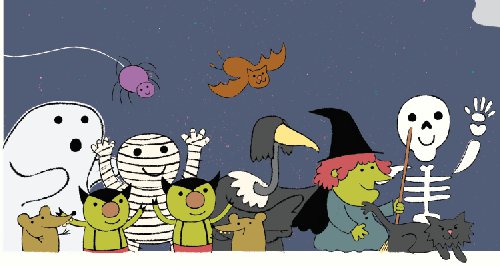



Also in early 2015, Viking is publishing Tricky Vic, a non-fiction picture book, aimed at a slightly older audience than my other books. It tells the story of a real con-artist who sold the Eiffel Tower for scrap metal — twice. I’m illustrating that right now. The art for the new version isn’t finalized yet, but I can show off these early things.
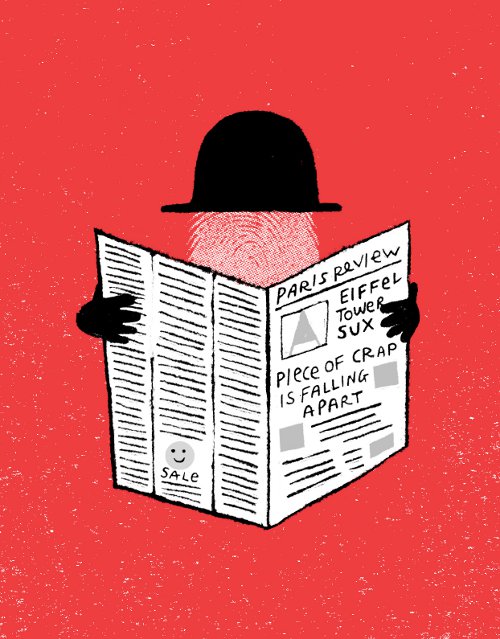




2015 will see at least three other books, but probably best to hold off on mentioning those for now. It’s all super exciting stuff — some fiction and some nonfiction.
 Coffee’s on, and it’s time to get a bit more detailed with seven questions over breakfast. I thank Greg again for visiting 7-Imp.
Coffee’s on, and it’s time to get a bit more detailed with seven questions over breakfast. I thank Greg again for visiting 7-Imp.
1. Jules: What exactly is your process when you are illustrating a book? You can start wherever you’d like when answering: getting initial ideas, starting to illustrate, or even what it’s like under deadline, etc. Do you outline a great deal of the book before you illustrate or just let your muse lead you on and see where you end up?
Greg: I think the process is a little different each time, but honestly, much of it is the same, too. I’m a creature of habit, and though I don’t keep a strict schedule where I, say, draw from 9-1 and then write from 2-6 everyday, there are things that I do the same with each book. I always make layout sheets with thumbnail-sized pages so I can see the whole book on one page.
(Click to enlarge)

And I do make at least one hand-made dummy for each book I make, usually with marker or colored pencil, if only to make certain the pacing and page turns work out. Some people don’t realize that it’s often up to the illustrator to figure out when the page turns should be and which text should be on which page. Most texts have a natural rhythm built in, and editors, of course, have a sense of how it should work, but publishers (so far) have given me the freedom to figure that part out.

When I’m writing the story myself, I usually have a sense of what the pictures will look like, as I write the lines. Some of those first ideas make it into the final book, and some get better through revision and help from my editor and art director.
I went into great detail here on my blog about making The Watermelon Seed, so I won’t cover that again, but I can talk about Number One Sam.
This story, like Watermelon, started with a character who kept showing up in my sketchbook and some prints. I made this print, and for whatever reason I kept drawing him, while sketching.

I first wrote a story called “Traffic Sam,” which was about Sam, the traffic reporter. It was about as interesting as traffic can be.
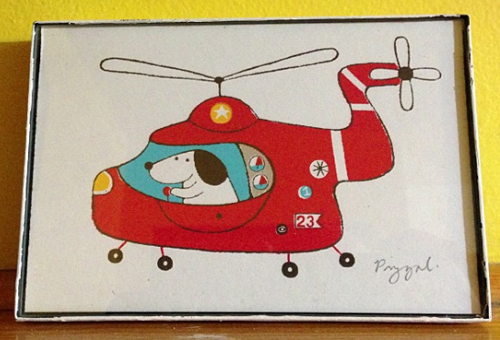
Then I decided he should be in a race car and wrote a story about a champion driver, whose vision goes fuzzy one day. He doesn’t want to wear glasses, ’cause the other animals make fun of him. This mining of personal tragedies from my own childhood comes easily.
But that got kind of “issue-y,” so I re-wrote it again. And again. And again.
And THEN, I thumb-nailed it out, scanned in sketches, sent them to Rotem, and she got back to me with line-by-line notes. We do a lot of figuring it out by email or on the phone.
Once we think we’ve got it, I get to work on final art, which for Number One Sam happened in Photoshop. Again, we got paper and ink samples to make sure we got the colors just right. The fact that we get to invest a little more time/energy/money into making these books special on the production end is really satisfying.

When it’s someone else’s text, I usually read the story several times and just try to break up the text in regards to the page turns. Then I just start sketching characters and coming up with ideas for how the book can work. Here are some early sketches from [Carol Brendler’s] Not Very Scary:
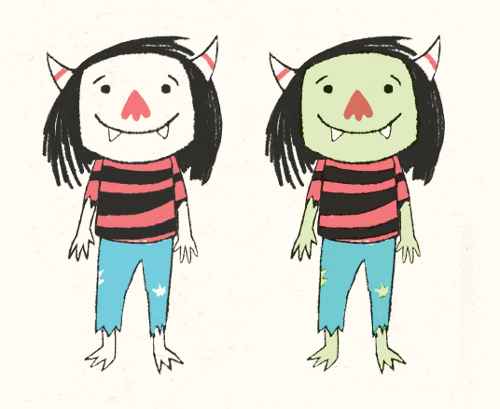


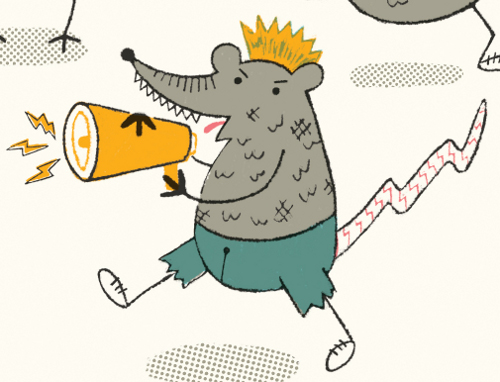


For [this book], the text has a cumulative build up of characters that grows to fifty-seven (or so) characters on some of the final spreads, so I had to plan a lot. You have to find a place for all of those characters to be, and they wouldn’t just be standing around. They would be interacting with one another, and those interactions should relate from spread to spread.
I used the sidewalk as a sort of a stage that the characters could enter and walk out on to. It might not be apparent to anyone but me, but I think there is a lot of Charles Schultz influence in this book.

 I also tried to get at the “other story” that Sendak often spoke about -– the something else that’s happening that isn’t expressed in the narrative text. One example of my attempts at this would be the witches, specifically the one who falls off her broom. Nowhere in the text is it mentioned that a witch falls off her broom. But I had one of the witches start falling on one spread, and then on the next spread she’s hanging there as the other witches come to help.
I also tried to get at the “other story” that Sendak often spoke about -– the something else that’s happening that isn’t expressed in the narrative text. One example of my attempts at this would be the witches, specifically the one who falls off her broom. Nowhere in the text is it mentioned that a witch falls off her broom. But I had one of the witches start falling on one spread, and then on the next spread she’s hanging there as the other witches come to help.
But then the lead witch bumbles the whole thing, and the other two get tangled and fall to the ground, which is what is causing all of the mummies, spiders, rats, skeletons, and everybody to run screaming on the spread where the vultures are introduced. They are about to have a crash landing. This type of thing might not even register with everyone; they may not notice. But it keeps it interesting for me, and I hope it makes it a little more interesting to those who do notice. Here are some close-ups so you can see what I mean:



Oh yeah. Plus, I referenced the Charlie Brown Christmas special directly:

2. Jules: Describe your studio or usual work space.
Greg: I work in an old warehouse building in Philadelphia. I draw at a desk with a computer and a light-box, and I’m surrounded by my favorite books. I share the space with my wife, Kay, who is gallery artist and teaches painting, printmaking, and book-arts full-time at a local college. We just put in a second window, so it’s feeling very nice. We have a silkscreen studio that we built as well. It’s got a little darkroom, a print area, a drying rack, a washout sink, and a massive exposure unit. It’s probably better described through pictures:
3. Jules: As a book-lover, it interests me: What books or authors and/or illustrators influenced you as an early reader?
Greg: I’m lucky enough to have kept a bunch of my books from when I was a kid. Don’t tell my first-grade teacher, but I stole this copy of Arnold Lobel’s Owl at Home from the classroom. I crossed out her name and wrote mine — the perfect crime! I actually don’t remember this and feel kind of bad about it. But I guess I have always loved this book. I see it as the form perfected. It’s amazing.
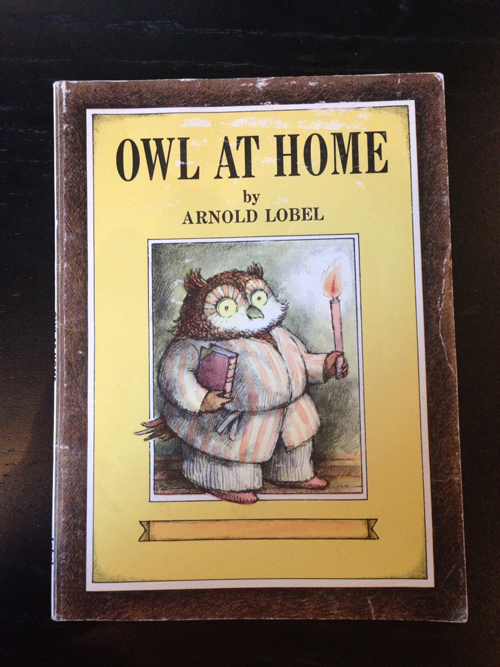
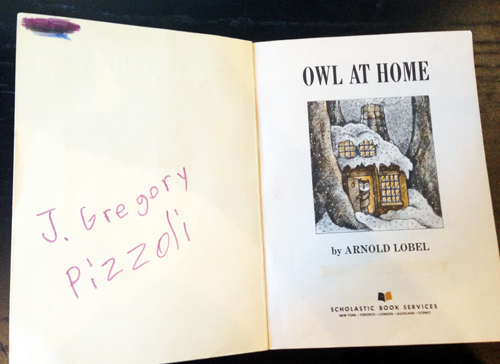
Other big ones were:
- Little Mouse, the Red Ripe Strawberry, and the Big Hungry Bear by Don and Audrey Wood
- Absolutely everything by Roald Dahl
- The Chronicles of Narnia
- Everything Richard Scarry, even the silly “Mystery of the Stolen Pie”-type books
- Everything Sendak, particularly his more cartoon-y stuff and anything with Ruth Krauss
- Henry’s Awful Mistake by Robert Quackenbush
- The Lake Mess Monster by Beverly Komoda
- But No Elephants by Jerry Smath
Maybe not the most sophisticated list, but I loved them all as a kid. I also got really into Michael Chrichton when the Jurassic Park movie came out. I was ten.

4. Jules: If you could have three (living) authors or illustrators—whom you have not yet met—over for coffee or a glass of rich, red wine, whom would you choose? (Some people cheat and list deceased authors/illustrators. I won’t tell.)
Greg:
- Roald Dahl
- James Marshall
- Ruth Krauss, and if she brought Crockett Johnson along, I wouldn’t complain.

5. Jules: What is currently in rotation on your iPod or loaded in your CD player? Do you listen to music while you create books?
Greg: I listen to loads of music and podcasts and audiobooks. I just got several audiobooks and have been blowing through them. I listen to lots of music, too. I like to draw to Gorillaz, DJ Shadow, The Clash, Autechre, Anti-Pop Consortium, MF Doom, The Pixies, Fugazi.
Don’t judge, hipster.

6. Jules: What’s one thing that most people don’t know about you?
Greg: I mistake noises/sounds for other things all the time. (My wife contributed this answer.)
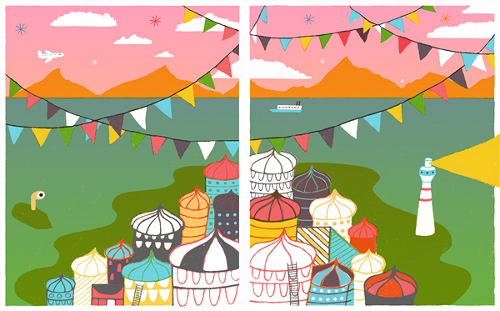
7. Jules: Is there something you wish interviewers would ask you — but never do? Feel free to ask and respond here.
Greg: Question: If I buy 10,000 copies of your book, will you be my friend?
Answer: Yes. Yes, I will.

Jules: What is your favorite word?
Greg: “Linguine.”
Jules: What is your least favorite word?
Greg: “Bril,” “Fab,” “Gorg,” etc.
Jules: What turns you on creatively, spiritually or emotionally?
Greg: Freedom.
Jules: What turns you off?
Greg: Expectations.
7-Imp: What is your favorite curse word? (optional)
Greg: The one Ralphie said that wasn’t “fudge.”
Jules: What sound or noise do you love?
Greg: The Clash.
Jules: What sound or noise do you hate?
Greg: Whistling and/or singing in public space.
Jules: What profession other than your own would you like to attempt?
Greg: I’d like to run a puppet theater.
Jules: What profession would you not like to do?
Greg: Messenger.
Jules: If Heaven exists, what would you like to hear God say when you arrive at the Pearly Gates?
Greg: “Welcome. Let me take you to your office. There’s the coffee maker. We packed your books.”

All artwork and images are used with permission of Greg Pizzoli.
The spiffy and slightly sinister gentleman introducing the Pivot Questionnaire is Alfred, © 2009 Matt Phelan.
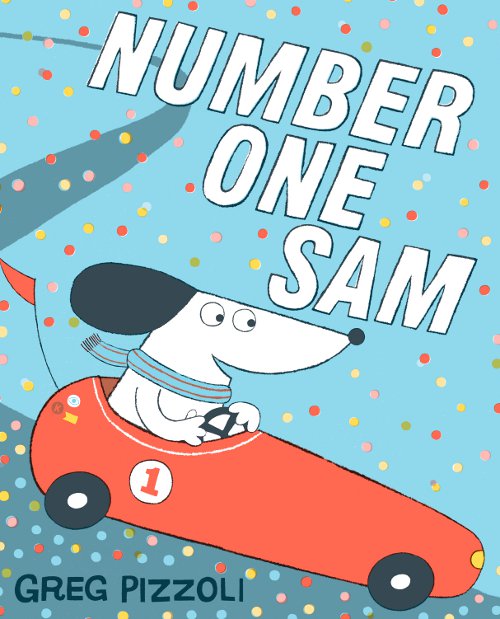


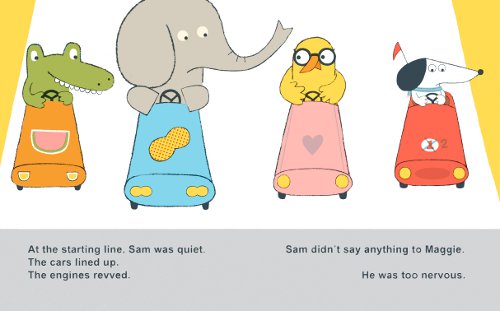







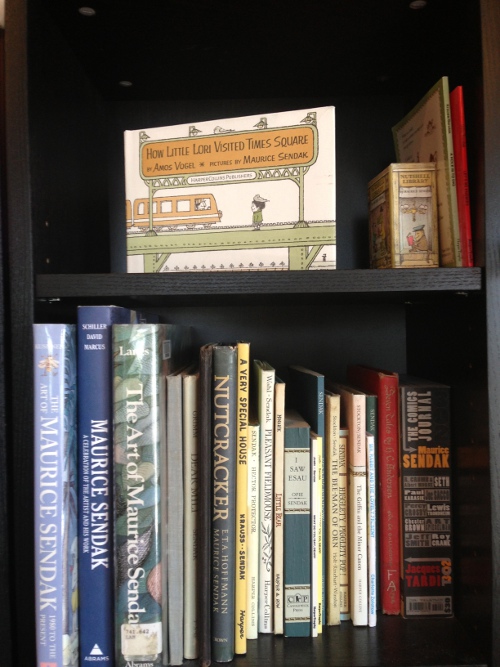


This is such a great interview! Love seeing all these pictures, love your SUPER DELUXE notebook, and that you have some books face out on your shelves. And so much love your answer to the final question.
Great interview, as always.
I have advice from Greg pinned over my drawing table, “Make a ton of work. . . . don’t obsess over failures.” It’s made all the difference this year.
Thank you both for this wonderful interview. I am over the moon with all the illustrations. I’ll add a link for this to my blog review of the book.
Great interview. Always happy to see yet another fan of Jerry Smath’s But No Elephants!
I still have my copy from childhood and read it to my class the first or second day of school every year. Such a wonderfully funny and simple book.
Someone really ought to reissue those old “weekly reader/parent’s choice”.
That was amazing! Thx as always 🙂
Thanks so much for sharing! Love Greg’s work and appreciate seeing the process.
LOVE LOVE LOVE!!! Greg’s work, great interview, GREAT guy!!!
Jules–
That was just fabulous!
I have a question that exposes my ignorance:
What are “spot colors?” He mentions them in the first section.
I love his work. The Geisel committee chose well!
Hi all, thanks for your comments about my work! I appreciate it.
Robin – Jules emailed and asked me if I could answer your spot color question. I hope so. Here goes:
Basically it means that the inks being used to print the books (like in the book-making-place, not my studio) the printers actually mix a specific color to my specifications (pink, green, black, etc) and use those inks to print the book instead of creating those colors using Cyan, Magenta, Yellow and Black inks the way they normally do (or the way, in a more crude manner, your inkjet printer might).
Spot color printing was the norm in kids books for a long time until CMYK became affordable and the norm, and now spot color printing seems reserved for special colors (I believe the orange in Mr. Tiger was a 5th color printed special after the CMYK – orange is notoriously hard to get with CMYK) and for enthusiasts like myself who have publishers generous enough to allow them to obsess over these things.
I have a background in printmaking, where colors are separated in this way anyway, so it’s not too difficult to get the book art finished in a way that allows for this kind of printing.
Hopefully it makes a difference for the reader in that the inks feel brighter, richer, and smell like a cool ocean breeze. Wait, scratch that last one.
Does that make sense?
Thanks Greg! I like knowing stuff like this!
Jules and Greg, this was one of the most enjoyable interviews EVER! Greg, thank you for posting the link in the #kidlitart chat tonight. It’s been too long since I’ve stopped by “Seven Imp”!
First, I have to say the artwork of you by your VERY talented pals is just hilarious 🙂 Also, I’ve never seen such “finished” thumbnails! I know when I do mine, they’re pencil sketches! It’s amazing, though, how clearly you can see how the whole book flows and ties together with content, composition and coloring when done this way. Love it!
And, of course, I have to comment/ask about your work space! It looks divine! It also looks exceptionally neat. Is this because a) you are naturally a tidy kind of guy? b) you straightened it up for the photos? c) your wife is tidy and/or straightened it up for the photos? 😉
Thanks for all the fun tonight, on Twitter and here! 😀 Thanks, Jules!
[…] Greg Pizzoli visits 7-Imp this morning to talk about his entertaining new picture book from Viking, Tricky Vic: […]
[…] Author-illustrator Greg Pizzoli visits 7-Imp today to tell us a bit about his newest picture book, Templeton Gets His Wish […]
[…] Sources: Author/Illustrator interview: Design of the Picture Book Author/Illustrator interview: Seven Impossible Things Before Breakfast […]
[…] and Marilyn Singer’s What’s an Apple? and What’s a Banana?, both illustrated by Greg Pizzoli and coming to shelves in August from […]
[…] Wanna take to the air with me today with both Margaret Wise Brown and author-illustrator Greg Pizzoli? […]
[…] Author website Author interview: Design of the Picture Book Author interview: Seven Impossible Things Before Breakfast Book trailer: Good Night […]
[…] and Mac Barnett’s I Love You Like a Pig (Balzer + Bray, September 2017), illustrated by Greg Pizzoli. Greg also shares some preliminary images […]
[…] to be very much still alive ….” Over at BookPage, I talk to author-illustrator Greg Pizzoli about his newest picture book, The Quest for Z: The True Story of Explorer Percy Fawcett and a Lost […]